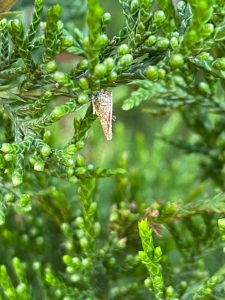
District Extension Agent, Horticulture
Southwind Extension District
111 S. Butler
Erie, KS 66733
Office: 620-244-3826
Cell: 620-496-8786
I did a little scouting two nights ago looking for newly hatched bagworms on cedar trees. Sure enough, they are out! You have to really look in order to see them because they are still small – about a ¼ inch in size.
Bagworms are a yearly pest in our area and can cause considerable damage. Most homeowners typically don’t get too concerned about bagworm control until they see large bags present on plants. By then it is too late and the damage is already done! The window of opportunity for optimum control is approaching.
Bagworms overwinter as eggs deposited in the female bags. From mid-May through mid-June, larvae hatch from the eggs and exit from the bottom opening of the old bag. Larvae begin constructing their miniature silk-lined bags immediately. Only after the bags have been completed do the larvae begin actual feeding activities. And as the larvae grow, so do their bags. By mid-to late August when feeding activities are complete, larvae firmly anchor their bags to the twigs and branches on which they were feeding.
Bagworms are most commonly found on eastern red cedar and junipers. However, bagworms can attack arborvitae, spruce and pine. Broadleaf trees, shrubs and ornamentals can also serve as a host to bagworms. After bagworms have defoliated a host plant, they are capable of migrating in search of additional food sources. They may attack the same species from which they came or a completely different species.
The damage caused by bagworm feeding can be minimal to severe. As larvae enter their later development stages, they require greater amounts of food. Sometimes in what seems to be just overnight, bagworms can completely defoliate a tree. Several successive years of heavy foliar feeding can result in the death a tree, especially with conifers.
There are two ways to control bagworms – cultural and chemical. Cultural practice is used by those who do not want to utilize insecticidal sprays to control bagworms. Instead, bagworms are eliminated by handpicking individual bags from plants. This is best done in the winter months when bags stand out against a trees background color. Keep in mind that a single missed bag could result in a thousand new bagworm larvae. Of course handpicking becomes impractical when a host is literally covered with bags or it is too tall to make handpicking possible.
Chemical control is most effective when larvae are in their early developmental stages. Generally, bagworm larvae will begin emerging from the overwintering bag by mid-to late May. Hatching does not happen overnight. Instead, hatching can continue for 4 to 5 weeks. Controls applied in late summer are often a waste of time and expense because the larvae are large, tough and may have stopped feeding. About the third week of June is the ideal time to make insecticidal control.
Insecticides commonly used to control bagworms include spinosad, acephate, cyfluthrin, or permethrin. These are sold under a variety of trade names. Check the product label for active ingredients.
For more information on bagworm control, please contact me at one of our Southwind Extension District office locations.
Krista Harding is a K-State Research and Extension Agricultural agent assigned to Southwind District. She may be reached at [email protected] or 620-244-3826.
K-State Research and Extension is an equal opportunity provider and employer.

